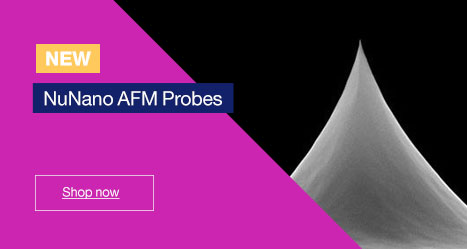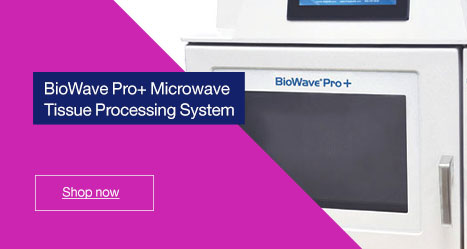The complete method for H&E staining is contained in the tables below, but we’ll take a look at each of the stages in turn and explain the process which should help you should you need to troubleshoot.
Dewax and rehydrate
The first stage in any histological staining or immunohistochemistry method is to dewax your sections on the slides. The paraffin needs to be removed to enable the aqueous solutions to penetrate the fixed tissue. This is usually done using either xylene or ‘Histoclear’. After the wax is removed (typically in three separate 5 minute immersions in dewaxing solution), the tissue needs to be rehydrated which is done through a decreasing series of alcohol solutions. In these first stages of an H&E protocol (or any immunohistochemical method) there’s not much to troubleshoot- you should ensure that most of the xylene is drained from the rack and slides before placing them in the 100% alcohol and also ensure that the slides are exposed to the air for the minimum amount of time between solutions. For the tap water stages of this protocol, I would recommend using a container within the sink with constantly running water- this helps to contain the excess stains from the slides which would otherwise stain the whole sink blue and pink!
Got the blues
As mentioned in the previous article, haematoxylin is used to dye the nucleus and binds to the histones with the aid of the metal salt, otherwise known as the ‘mordant’. A five minute submersion in haematoxylin is standard- this relatively long time ensures that all of the available nuclear binding sites are saturated.
This method of staining is known as ‘regressive’ staining. The tissue is incubated for a long period to allow for deliberate over-staining and then some of the stain is removed in a step called ‘differentiation’. The other method is ‘progressive’ staining where the solution of haematoxylin may not be as concentrated and the tissue is checked at regular intervals until the desired intensity is reached. Personally, I have always used the former method as it’s probably the easiest and in the end is less time-consuming as you don’t need to keep taking the slides from the haematoxylin, submersing them in tap water and checking the intensity using a microscope.
When you take your slides out of the haematoxylin, all will be blue! Initially, the nuclei will be deep purple/blue/, but the differentiation stage will render the stained nuclei dark blue. If you over-differentiate, fear not! Most of the stages of the H&E method can be repeated and the final colour can be adjusted.
Differentiation and Bluing
To achieve the blue coloured nuclei, there are two stages. The first is the differentiation stage. After the tap water rinse, the slides are submerged for a short period of time in an acid-alcohol solution which removes the excess staining. At this stage, the nuclei will be very dark and deep purple in colour. To achieve the classic H&E blue colour, the slides are rinsed then submerged in a solution called ‘Scotts Tap Water’. This second stage is known as ‘bluing’.
The use of tap water (as opposed to distilled water) is important in these stages and bluing can be achieved with tap water alone (depending on the intensity of the staining following the haematoxylin stage). Tap water is slightly acidic (pH of around 6.0 to 6.8), but this is more alkaline than the pH of the haematoxylin which tends to be around pH 2.7. Two to five minutes in running tap water will remove most of the excess mordant giving sharp blue nuclear staining.
Eosin
The aim of H&E staining is to achieve a contrast between the deep blue nuclei and red/pink of the other cellular components. Eosin is used to stain cytoplasm, muscle fibres and so on. This pink counterstain also helps to differentiate between nuclei and non-nuclear components in cells. Don’t be tempted to over-stain at this stage- always err on the side of caution. Over-staining can result in cells which are not immediately easy to differentiate. You can remove a certain amount of over-stain in running tap water.
Some methods suggest that Eosin is diluted in ethanol, but I would recommend a solution in water as the ethanol has the potential to remove the haematoxylin staining from the previous stages.
Method
This is a basic method for H&E staining in which I have split into two sections: the dehydration/rehydration section (for rehydration following the eosin/tap water rinse, simply follow Step 9 to Step 1 before mounting the slides).
Dehydration/Rehydration
| Step | Solution | Time | Notes |
| 1 | Xylene | 5 mins | These steps should be carried out in a fume hood or downflow bench |
| 2 | Xylene | 5 mins | |
| 3 | Xylene | 5 mins | Drain off excess xylene before (4) |
| 4 | Absolute ethanol | 20 secs | |
| 5 | Absolute ethanol | 20 secs | |
| 6 | Absolute ethanol | 20 secs | |
| 7 | 95% ethanol | 20 secs | |
| 8 | 80% ethanol | 20 secs | |
| 9 | 70% ethanol | 20 secs | |
| 10 | Tap water | 2 mins | Running tap water in a sink |
H&E Staining
| Step | Solution | Time | Notes |
| 1 | Harris’ Haematoxylin | 5 mins | Run control slides first to check times and staining. |
| 2 | Tap water | 20 secs | Running tap water in a sink |
| 3 | 1% Acid alcohol | 5 secs | 5 secs is maximum time in this solution |
| 4 | Scotts Tap Water | 2 mins | Until tissue sections turn blue |
| 5 | Eosin | 2 mins | |
| 6 | Tap water | 20 secs | Running tap water in a sink, then check slides. |
The nuclei in the cells should be dark blue whereas the cytoplasm will be pink. Fibrin and muscle will be deep pink and collagen will stain pale pink. Any erythrocytes will be red.
Remember to allow any excess fluid to drain back into the staining dish before proceeding to the next step.
Slides are mounted directly from the last xylene step.
Author: Martin Wilson


